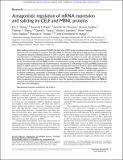| dc.contributor.author | Giudice, Jimena | |
| dc.contributor.author | Treacy, Daniel J. | |
| dc.contributor.author | Saxena, Tanvi | |
| dc.contributor.author | Cooper, Thomas A. | |
| dc.contributor.author | Ward, Amanda | |
| dc.contributor.author | Cherone, Jennifer Michelle | |
| dc.contributor.author | Freese, Peter Dale | |
| dc.contributor.author | Wang, Thomas | |
| dc.contributor.author | Lambert, Nicole | |
| dc.contributor.author | Burge, Christopher B | |
| dc.contributor.author | Wang, Eric T | |
| dc.date.accessioned | 2015-05-22T18:02:05Z | |
| dc.date.available | 2015-05-22T18:02:05Z | |
| dc.date.issued | 2015-04 | |
| dc.date.submitted | 2014-09 | |
| dc.identifier.issn | 1088-9051 | |
| dc.identifier.issn | 1549-5469 | |
| dc.identifier.uri | http://hdl.handle.net/1721.1/97060 | |
| dc.description.abstract | RNA binding proteins of the conserved CUGBP1, Elav-like factor (CELF) family contribute to heart and skeletal muscle development and are implicated in myotonic dystrophy (DM). To understand their genome-wide functions, we analyzed the transcriptome dynamics following induction of CELF1 or CELF2 in adult mouse heart and of CELF1 in muscle by RNA-seq, complemented by crosslinking/immunoprecipitation-sequencing (CLIP-seq) analysis of mouse cells and tissues to distinguish direct from indirect regulatory targets. We identified hundreds of mRNAs bound in their 3′ UTRs by both CELF1 and the developmentally induced MBNL1 protein, a threefold greater overlap in target messages than expected, including messages involved in development and cell differentiation. The extent of 3′ UTR binding by CELF1 and MBNL1 predicted the degree of mRNA repression or stabilization, respectively, following CELF1 induction. However, CELF1's RNA binding specificity in vitro was not detectably altered by coincubation with recombinant MBNL1. These findings support a model in which CELF and MBNL proteins bind independently to mRNAs but functionally compete to specify down-regulation or localization/stabilization, respectively, of hundreds of mRNA targets. Expression of many alternative 3′ UTR isoforms was altered following CELF1 induction, with 3′ UTR binding associated with down-regulation of isoforms and genes. The splicing of hundreds of alternative exons was oppositely regulated by these proteins, confirming an additional layer of regulatory antagonism previously observed in a handful of cases. The regulatory relationships between CELFs and MBNLs in control of both mRNA abundance and splicing appear to have evolved to enhance developmental transitions in major classes of heart and muscle genes. | en_US |
| dc.description.sponsorship | Myotonic Dystrophy Foundation | en_US |
| dc.description.sponsorship | National Institutes of Health (U.S.) (Grant OD017865-02) | en_US |
| dc.description.sponsorship | National Science Foundation (U.S.) (Award 0821391) | en_US |
| dc.description.sponsorship | National Institutes of Health (U.S.) (Grant R01GM085319) | en_US |
| dc.description.sponsorship | National Institutes of Health (U.S.) (Grant RC2HG005624) | en_US |
| dc.language.iso | en_US | |
| dc.publisher | Cold Spring Harbor Laboratory Press | en_US |
| dc.relation.isversionof | http://dx.doi.org/10.1101/gr.184390.114 | en_US |
| dc.rights | Creative Commons Attribution | en_US |
| dc.rights.uri | http://creativecommons.org/licenses/by/4.0/ | en_US |
| dc.source | Cold Spring Harbor Laboratory Press | en_US |
| dc.title | Antagonistic regulation of mRNA expression and splicing by CELF and MBNL proteins | en_US |
| dc.type | Article | en_US |
| dc.identifier.citation | Wang, Eric T., Amanda J. Ward, Jennifer M. Cherone, Jimena Giudice, Thomas T. Wang, Daniel J. Treacy, Nicole J. Lambert, et al. “Antagonistic Regulation of mRNA Expression and Splicing by CELF and MBNL Proteins.” Genome Res. (April 16, 2015). | en_US |
| dc.contributor.department | Massachusetts Institute of Technology. Computational and Systems Biology Program | en_US |
| dc.contributor.department | Massachusetts Institute of Technology. Department of Biology | en_US |
| dc.contributor.department | Koch Institute for Integrative Cancer Research at MIT | en_US |
| dc.contributor.mitauthor | Wang, Eric Tzy-shi | en_US |
| dc.contributor.mitauthor | Ward, Amanda | en_US |
| dc.contributor.mitauthor | Cherone, Jennifer Michelle | en_US |
| dc.contributor.mitauthor | Wang, Thomas T. | en_US |
| dc.contributor.mitauthor | Treacy, Daniel J. | en_US |
| dc.contributor.mitauthor | Lambert, Nicole J. | en_US |
| dc.contributor.mitauthor | Freese, Peter Dale | en_US |
| dc.contributor.mitauthor | Saxena, Tanvi | en_US |
| dc.contributor.mitauthor | Burge, Christopher B. | en_US |
| dc.relation.journal | Genome Research | en_US |
| dc.eprint.version | Final published version | en_US |
| dc.type.uri | http://purl.org/eprint/type/JournalArticle | en_US |
| eprint.status | http://purl.org/eprint/status/PeerReviewed | en_US |
| dspace.orderedauthors | Wang, Eric T.; Ward, Amanda J.; Cherone, Jennifer M.; Giudice, Jimena; Wang, Thomas T.; Treacy, Daniel J.; Lambert, Nicole J.; Freese, Peter; Saxena, Tanvi; Cooper, Thomas A.; Burge, Christopher B. | en_US |
| dc.identifier.orcid | https://orcid.org/0000-0002-0019-5296 | |
| dc.identifier.orcid | https://orcid.org/0000-0001-7256-6845 | |
| dc.identifier.orcid | https://orcid.org/0000-0001-5060-1646 | |
| mit.license | PUBLISHER_CC | en_US |
| mit.metadata.status | Complete | |
